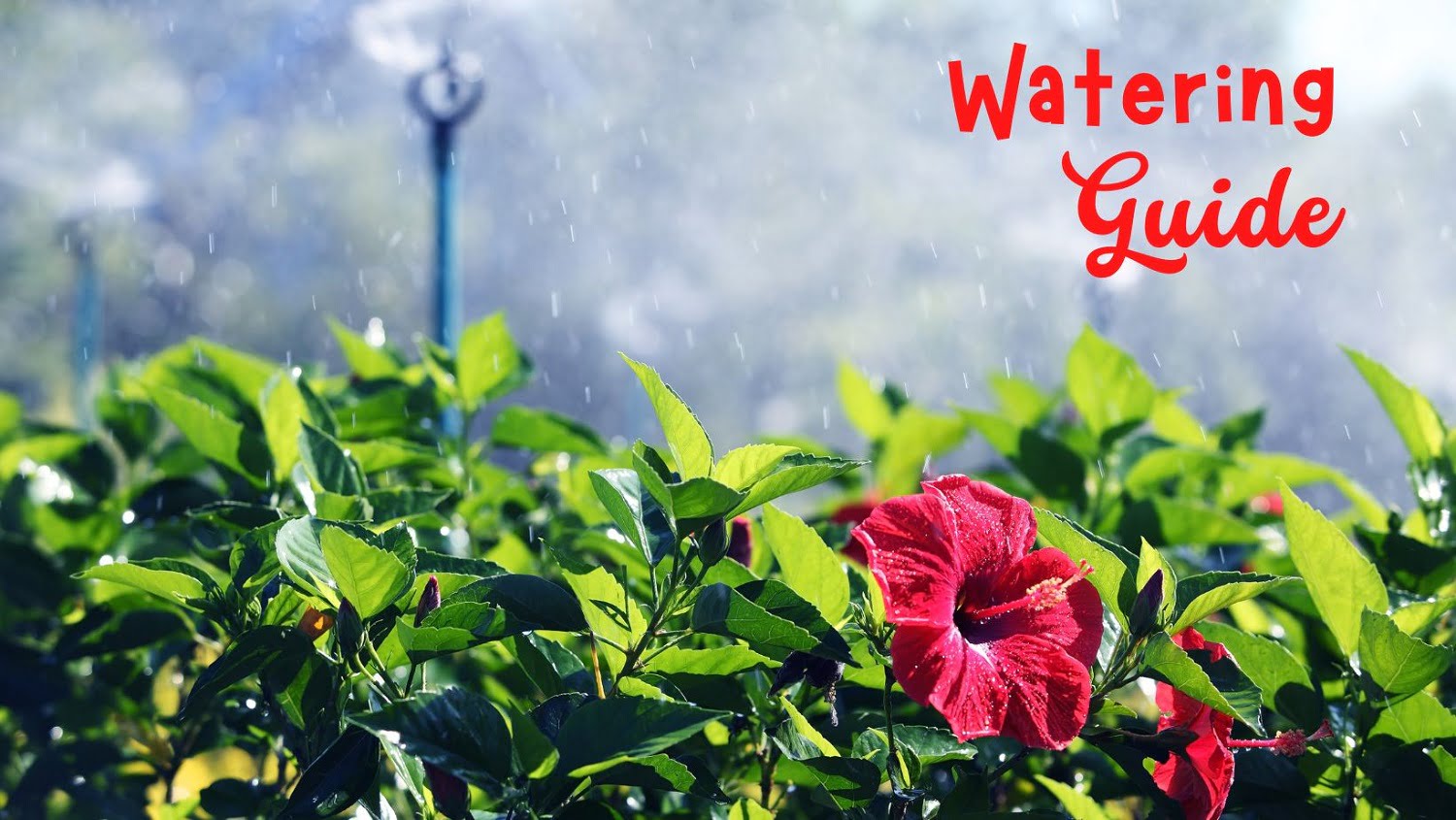
You cannot do anything without water – not even gardening. Both your lawn as well as your pots need adequate water to stay healthy and to bloom. But watering the right way is not so easy as it sounds, as it depends not only on the quantity, but also the frequency.
If you are reading this, then perhaps you have realized this issue, which is why we are here to help you out.
So, if you are wondering how often do you need to water your Hibiscus and how much water do they require? And most importantly, how to water them correctly? Well, we have the answers for you.
What Is The Need To Water Hibiscus Plant?
Did you know that plants are made up of more than 90 percent water?
This means that their entire system relies on a constant supply of water to distribute vital micro- and macronutrients all throughout its branches and leaves. That goes for hibiscus too, because it needs sufficient water to carry out its metabolic processes.
While a certain deficiency of water can initially be compensated by the cells of the plant, causing them to lose their Hydrostatic pressure (also called Turgor pressure). However, prolonged underwatering will eventually kill them. This is because Hydrostatic pressure plays an important role in stabilizing the plant by providing resistance to gravity as well as strong winds.
You may have observed this phenomenon at some point, especially in summers when the hibiscus looks wilted on a hot sunny day, but returns to its original state after adequate watering.
Above all, water is essential for photosynthesis, which hibiscus (in fact all plants) use to convert the sun’s energy into their own food.
How Much Water Does Hibiscus Need?
All varieties of hibiscus are water-loving and require generous amount of water, depending on the time of year and the prevailing weather conditions.
Originating from tropical areas, these plants love humidity and moisture in the air. And since not every one of us live in tropical areas, we need to artificially create such an environment to maintain their natural life cycle.
But determining how much water is needed by Hibiscus depends on how well the soil around these plants is hydrated. Which is basically concluded by doing some trial and error as it primarily depends on the environment where the plant is growing.
The first step is to take a measuring container and pour water from it on the Hibiscus plant until it starts to drain out. Now measure the amount poured and reduce it slightly so that no more water leaks out from the pot the next time you water. This is to ensure that the entire root ball of your hibiscus receives enough water without allowing important nutrients to seep out from the drain holes.
If your hibiscus is growing in the garden, this might be a bit tricky to analyze at first. So, the key here is to use a pencil to dig a small hole near the plant to help analyze the moisture content of the soil. If the soil is moist 15 to 20 cm below the ground, it means that you have watered sufficiently.
In case the soil does not absorb the water easily, or the water remains on the surface for a long time before getting absorbed by the soil, then the moisture content in the soil is already very high. So, you will have to reduce the quantity the next time you decide to water your hibiscus.
Pro Tip- A 12-inch hibiscus planter placed in full sun needs about 1 liter of water to get fully moist during summers.
How Often Do I Need To Water Hibiscus In Summer?
The sharp rise in temperature and prolonged exposure to sun are particularly hard on hibiscus: On one hand, they need a lot of water due to their tropical nature, and on the other, they have to release most of it through their leaves in order to regulate their temperature.
This is why adequate watering of hibiscus, be it in the garden or on the balcony, is absolutely necessary for it to remain unscathed throughout the season.
And it’s better to water the garden bed thoroughly every second day, rather than spraying water superficially every day. This will help the soil to retain its moisture and will allow hibiscus to deepen its roots.
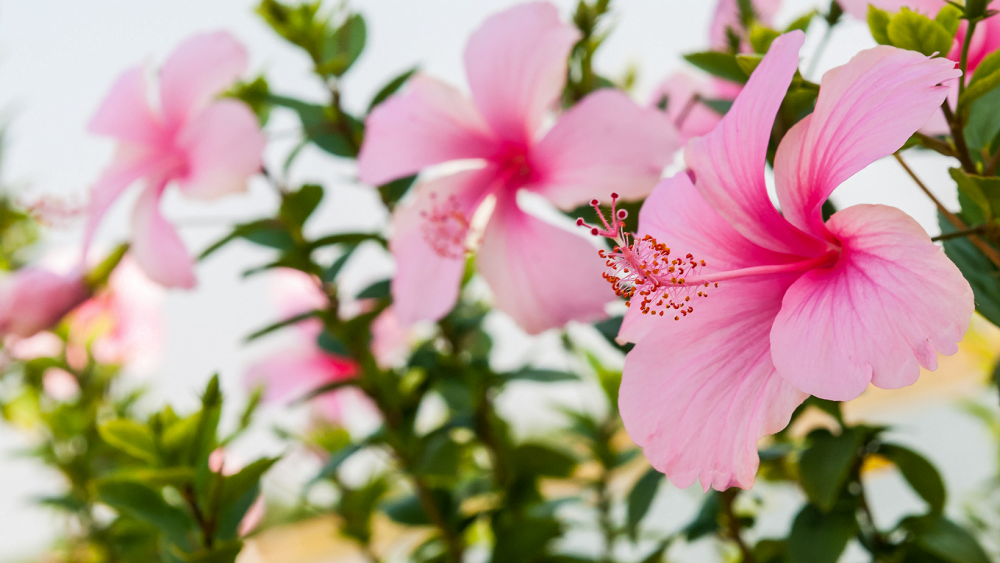
Needless to say, the frequency of watering depends on whether your hibiscus is in full sun and therefore needs a lot of water every day, or if it is in the shade and not quite as parched.
That said, Hibiscus grown in pots needs to be watered daily because unlike those grown in the garden or lawn, they can’t develop deep roots.
Also, during intense heat or dry conditions, it is recommended to water the plants twice a day.
These tips will help you create a plan of action:
- Water once a day when the temperature is between 25 and 35°C.
- Water twice a day when the temperature is between 35 and 40°C.
- Regions where temperature can exceed 40°C, it is advisable to water the hibiscus three times if the plant is exposed to direct sunlight all day. Alternatively, we recommend placing them in partial shade and water twice a day.
- If you live near the coast or in regions where rainfall is occasional, you may need to reduce the frequency of watering but maintain the quantity.
- If the hibiscus looks droopy after following a particular watering schedule, place the flower pot (it must have a drainage hole) in a container (tub or bucket) filled with water. This will allow the soil to properly soak up water. Then water again as usual, but this time increase the frequency.
How Often Do I Need To Water Hibiscus In Winter?
Plants like hibiscus can easily survive cold weather. For their biggest enemy here is not the cold, but the accompanying drought.
This is because snowfall barely reaches beyond the surface of the ground. In addition, the ground is usually frozen, so the plant cannot absorb moisture from there too.
And even if your Hibiscus somehow manages to absorb some of it, the majority of it evaporates quite quickly in the sun (due to the phenomenon of transpiration). Therefore, watering your hibiscus is just as important in the winter as it is in the summer.
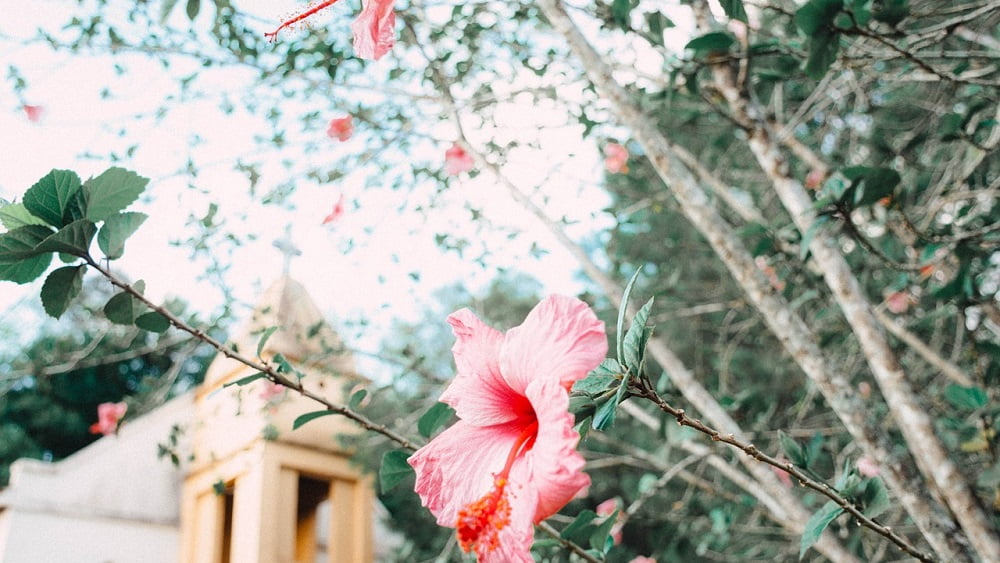
Ideally, watering should be done during the day when the temperature is at its highest. This is because watering in the evening can cause it to freeze overnight which can in turn damage the roots.
These tips will help you create a plan of action for the winter:
- The soil in the pot should be completely dry before you water again.
- If the temperature is below freezing, watering once a week is usually sufficient; if the temperature is above freezing, watering twice a week is ideal.
- The lower the temperature, the less often you need to water.
- On cold days, sprinkling tap water that is well above the outside temperature will surely help your hibiscus absorb the required moisture.
How To Test If Hibiscus Needs Water?
There are several ways to determine the exact water requirements for your hibiscus plant. The first and simplest method is to analyze the soil below 15 centimeters of the ground (5cms in case of pots): if it is moist, you have watered sufficiently.
If you have watered too little, the soil will feel dry and dusty. However, you should not immediately start pouring liters of water to the soil. Instead, use a measuring cup and note the amount of water you are providing to the soil for future reference.
You can also tell if your hibiscus needs water by looking at the leaves. If you don’t water enough, the leaves will become paler and may even fall off. On a hot day, you may even see dullness. So, if you see these symptoms, it is because your hibiscus is not getting enough water.
On the other hand, you have watered too much if the soil is really wet or if there is some water visible on the top soil. This usually happens when the soil is saturated and cannot absorb any more water. And so, the residual water remains on the surface of the soil.
How Do I Know If I Have Watered Hibiscus Just Enough?
The amount of water that needs to be added on the Hibiscus completely depends on how much water the potting soil can absorb. If you water too little, the entire root ball will not be moistened. If you water too much, the roots of the plant will be covered with a layer of water. If you water the right amount, the entire root ball will be moist without getting drained from the bottom.
For Hibiscus grown in pots, finger test is recommended. Simply stick your finger deep into the soil and check for moisture. If the soil is evenly moist, you have watered sufficiently. For lawns, a pencil can be used. All you need to do here is poke a small hole in the lawn and check how deeply soaked it is. For optimal hydration, the moisture should reach as deep as 15 centimeters into the soil.
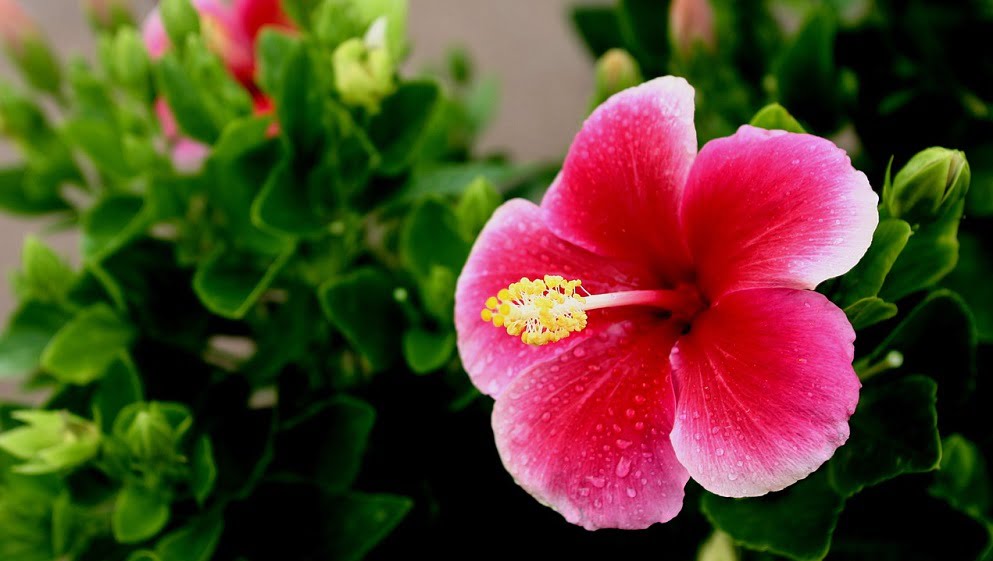
Do keep in mind that if Hibiscus has been kept dry for a long time, it is not advisable to water it more than usual. This is because the roots can absorb only a limited amount of water, and overcompensation can only lead to root rot.
How Do I Know If I Have Overwatered My Hibiscus?
There are simple tell-tale signs that a plant has been over-watered. The first, needless to say is visible on the surface of the soil itself. If upon touching instead of light moisture or dampness, the soil is really wet (even before watering) then this is a clear sign of overwatering.
You should immediately reduce the frequency of watering as this practice, particularly for the ones grown in pots, will lead to root rot. In addition, the leaves of excessively watered Hibiscus turn yellow or brown and buds start dropping before blooming (read this article that explains how you can revive an overwatered hibiscus plant).
So, on one hand Hibiscus is a water loving plant, but on the other, it only needs it when the top soil layer is dry to a depth of about 5cm.
How Do I Know If I Have Underwatered My Hibiscus?
Wilting leaves that look completely lifeless is a sign of underwatering. If the soil separates from the pot, this is another sign of underwatering. If this is the case, increase the frequency of watering.
Things To Know Before Watering Indoor Hibiscus Plant
For hibiscus grown indoors, the frequency of watering does not need to be adjusted according to season as much in comparison to the ones grown outdoors.
However, if they are located in heated rooms, watering should be more frequent. But here, too, the same principle is applicable: water when the soil is dry.
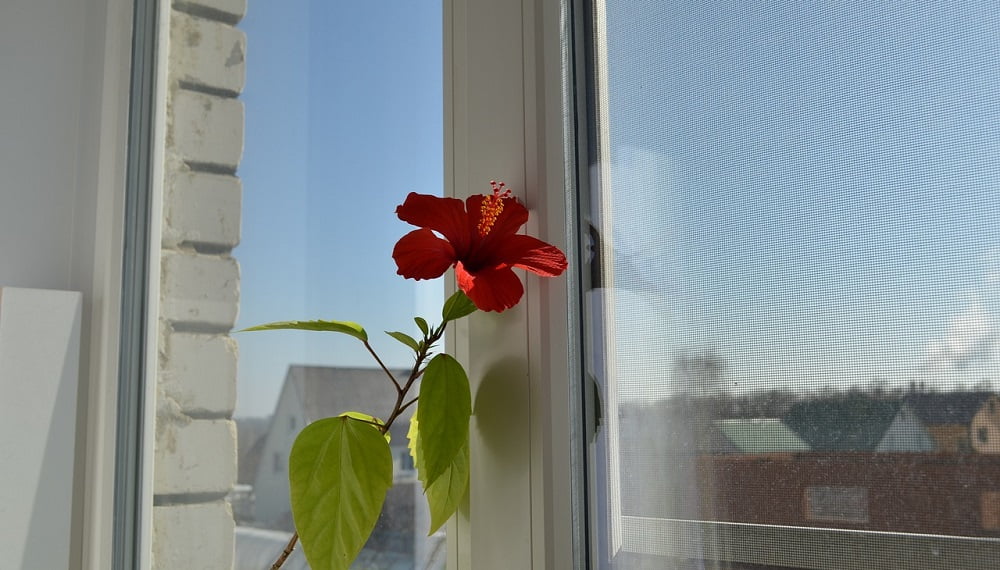
And if some water seeps out from the holes of the pot, be sure to remove it from the saucer to ensure adequate ventilation.
Most importantly, it is important to spray some water on the leaves in case of heated rooms. Alternatively, you can install an electric humidifier.
Should I Use Tap Water Or Distilled Water On Hibiscus?
Depending on the region, the values of both calcium and magnesium may vary. If you are certain that the water supplied to your house is not very hard and is not treated with chlorine, then this is the most economical and convenient way of watering.
Remember that water is a neutral agent, so it is neither acidic nor basic. To validate this, you can test your tap water using litmus paper (it will change color if the water is acidic or alkaline).
Distilled water, on the other hand, should never be used for watering hibiscus. However, if your tap water is not suitable for watering and you are using distilled water as your last alternate, it is important to provide additional micronutrients along with water.
If you have a filtration system installed, use filtered tap water instead, as filtration reduces the lime content in water and makes it soft.
Tip- Nothing beats rainwater as it is very soft and low in lime. Place your pots outside when it rains so that they get all the essential nutrients naturally.
What Time Of The Day Is Best For Watering Hibiscus?
In summers, the best time for watering hibiscus is morning, before the sun shines. This applies both to plants that grow in pots, and those that are in the garden. This is because at this time of day, water does not evaporate as quickly and can penetrate deep into the soil. If it is particularly hot, it is also advisable to water them again in the evening.
However, if you feel that your hibiscus is parched and needs to be watered immediately, you should not wait for an ideal time – if the plant is thirsty, it is thirsty. In this case, you should water your hibiscus immediately to prevent it from wilting.
The same applies to hibiscus grown in lawns and gardens. But here you should water more, but less often. This will encourage deep root growth – the deeper the roots in the soil, the better the plant can feed itself.
As for winter, the best time of the day is mid-day, when the temperature is comparatively the highest and the probability of water freezing around the roots is much less.
Should I Spray On The Plant Or Add Water Directly To Soil?
A common misconception among beginners is that water droplets on the leaves of Hibiscus will burn them when exposed to direct sunlight. So instead of cooling them down, spraying the leaves with water can burn them.
The truth is, however, that hibiscus doesn’t mind occasional water sprays on its leaves and flowers. In fact, it helps them stay hydrated and prevents them from wilting.
Ideally, it is recommended that water be added directly to the soil accompanied by occasional water sprays. This is because too much sprinkling can encourage the development of fungus.
Bottom Line
Hibiscus needs water all year round. Only the frequency of watering must be adjusted depending on the season. All you need to do is be flexible in your schedule.
If you feel that the temperature is extremely hot, water more often. And when the temperature starts to drop, reduce the frequency.
But remember, even if a plant is water loving – like Hibiscus, it doesn’t mean that it needs to be waterlogged every now and then.
Once you have determined the amount of water your Hibiscus pot can hold, or the amount of water sufficient to penetrate the roots if grown in garden, all you have to do is alter the frequency of watering depending on the temperature and sunlight.
Speaking of sunlight, do take a look at this detailed guide to understand how much sunlight your Hibiscus requires.
Good luck!

